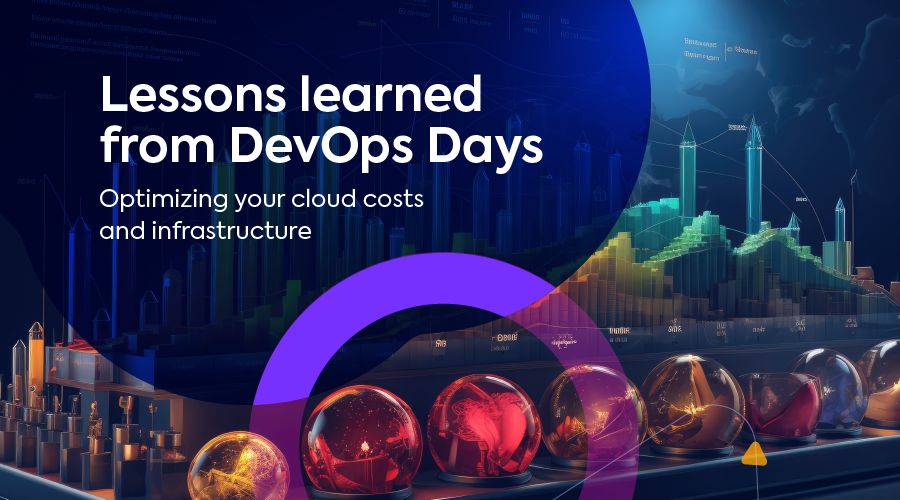
On October 31 the main floor of the DevOps Days TLV Expo was bustling with Halloween-themed booths of exciting DevOps vendors, offering treats for badge scans and whisky shots for “personal secrets”! It was a beautiful display of business-as-usual in unusual times—a worthy prelude to the upcoming winter event season. Here are some key lessons from the Spot booth you might want to bring along for the upcoming FinOpsXE, Ignite, and re:Invent.
#1: Autoscaling at scale
Open source tools are often the first choice for DevOps engineers owing to their cost-effective nature. But scaling up brings with it certain complexities. At our booth, two savvy DevOps engineers from a health-tech startup were happy with their open source autoscaler, but admitted that as their app gains more users, they would need a solution for better infrastructure management.
As a small, but mighty, 2-person dev team they recognized that scaling up was easy to automate, but scaling down without breaking anything required precision. Avoiding waste due to overprovisioning and suboptimal VM pricing requires a solution with robust ML.
#2: Syncing commitments with deployments
The age-old conflict of spot instances versus long-term commitments is again in the spotlight. While fault-tolerant workloads can run perfectly on spot instances, even in production, most businesses employ a siloed approach, buying long-term commitments based on a rough assumption and only using spot instances ad-hoc and sporadically.
This often leads to challenges: You either overcommit but underutilize the compute you purchased and are locked-in, or you under commit and must spend more money to cover the surplus with spot instances. In both cases, you are wasting money, because you are not achieving the maximum savings possible.
What struck a chord with many was the availability of an automated solution that can balance the choice between the two and seems like an ideal way forward for maximum savings and efficiency.
#3: FinOps as more than dashboards
Another key learning was the evolving perception of FinOps. One engineering team from a global software company was looking to help their company optimize cloud costs. Currently their optimization process was fragmented with recommendations coming from an external consultant along with a manual review of their cloud estate. Any adjustments had to be made manually as well, making the ROI for cost optimizations small. When asked about their FinOps journey, they quickly shared that it “wasn’t a pain because they had cloud cost dashboards”. But is that all FinOps is—cloud visibility?
Today, DevOps teams that see FinOps as an integrated cycle of visibility, cost optimization, and infrastructure optimization can add increasing value to the business.
#4: Maximizing throughput, not minimizing costs
In a session about developer productivity, the message was that productivity means maximizing throughput (as in, code written) rather than minimizing costs (as in, laying people off and overworking the remaining staff). Similarly, the ethos of FinOps is to extract the maximum value for each dollar spent on cloud services. Thus, the ultimate goal is to optimize capacity and cost for the best possible performance.
A “DevOps horror stories” session I attended put this principle into practice. It advised setting alarms on anomalous cloud resource usage, rather than cost. Usage, they said, was the real-time metric that engineers could do something about.
But never forget, usage generates costs—not vice versa. Therefore, in the FinOps context, an engineer’s job is to determine what capacity will maximize their throughput. Then, the FinOps practitioner must figure out how to get them this capacity—no less and no more—at the lowest possible cost, with workload consistency intact. This is what Spot is all about.
Conclusion
As the world gears up for upcoming events like FinOpsXE, Ignite, and re:Invent, the focus remains on how to optimize the cloud and get the most out of it. As you plan your agenda, take a few minutes to think about your cloud estate’s efficiency:
- How do you make sure you’re getting the most compute power for your buck?
- How much of your paid-for capacity is wasted, where, and why?
- How do you align your commitments with application usage?
If you’re looking to discuss more about what you can do to optimize your cloud, visit us as these upcoming events:
- FinOps XE in Barcelona, November 11-13, 2024
- Microsoft Ignite in Chicago, November 18-22, 2024
- re:Invent in Las Vegas, December 2-6, 2024
Curious about how FinOps and engineering can align? Read this summary of the new Harvard Business Review FinOps white paper.

